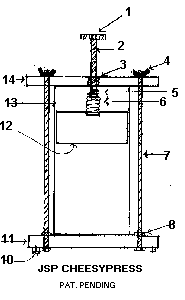I got one of these years ago and I just pulled it out of the storage bin that I had it in. It still had the plastic wrap that it came in on it! I bought it thinking that I was going use it and I never did! Since I finally took a class and got the training I needed I remembered that I had it stored away. It says that it can make a 2lbs wheel and can make 50lbs of pressure when the spring is fully compressed. I want to press out some Gouda with it. I know that its not the best thing out there because of the spring action and the 4"PVC pipe that it calls a hoop BUT since got this thing I would like to use it. Have any of you used this type of press? Any tips?
Here's a link to the directions
http://schmidling.com/ins.pdf 
1. Plastic threaded knob *
2. Threaded rod, 1/4-20 x 6"
3. Threaded bushing *
4. Wing nut, two places
5. Nut/washer/nut
6. Spring, 50 lbs fully compressed
7. Threaded rod, 1/4-20 X 9", two places
8. Nuts, top and bottom, two places
10. Rubber feet, 4 places
11. Base, polyethylene, 5 X 7 X 1/2
12. Follower, polyethylene, 3.930" X .5"
13. Hoop, PVC, 4" id X 8"
14. Screw Support Arm, Stainless, 1" X 7" X 3/16" *
